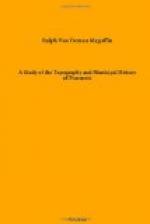The reasons why this is the oldest circuit of the city’s walls are the following: first, all this stretch of wall is the oldest and was built at the same time; second, topography has marked out most clearly that the territory inclosed by these walls, here and only here, fulfills the two indispensable requisites of the ancient town, namely space and defensibility; third, below the gate San Francesco all the way round the city as far as Porta del Sole, neither in the wall nor in the buildings, nor in the valley below, is there any trace of cyclopean wall stones;[34] fourth, at the point where the cross wall and the long wall must have met at the east, the wall makes a change in direction, and there is an ancient postern gate just above the jog in the wall; and last, the cyclopean wall from this junction on down to near the Porta del Sole is later than that of the circuit just described.[35]
The city was extended within a century perhaps, and the new line of the city wall was continued on the east in cyclopean style as far as the present Porta del Sole, where it turned to the west and continued until the hill itself offered enough height so that escarpment of the natural cliff would serve in place of the wall. Then it turned up the hill between the present Via San Biagio and Via del Carmine back of Santa Maria del Carmine. The proof for this expansion is clear. The continuation of the cyclopean wall can be seen now as far as the Porta del Sole,[36] and the line of the wall which turns to the west is positively known from the cippi of the ancient pomerium, which were found in 1824 along the present Via degli Arconi.[37] The ancient gate, now closed, in the opus quadratum wall under the Cardinal’s garden, is in direct line with the ancient pavement of the road which comes up to the city from the south,[38] and the continuation of that road, which seems to have been everywhere too steep for wagons, is the Via del Carmine. There had always been another road outside the wall which went up a less steep grade, and came round the angle of the wall at what is now the Porta S. Martino, where it entered a gate that opened out of the present Corso toward the west. When at a later time, probably in the middle ages, the city was built out to its present boundary on the west, the wagon road was simply arched over, and this arch is now the gate San Martino.[39]
It will be necessary to speak further of the cyclopean wall on the east side of the city from the Porta del Sole to the Portella, for it has always been supposed that this part of the wall was exactly like the rest, and dated from the same period. But a careful examination shows that the stones in this lower portion are laid more regularly than those in the wall above the Portella, that they are more flatly faced on the outside, and that here and there a little mortar is used. Above all, however, there is in the wall on one of the stones under the house no. 24, Via della Fontana an inscription,[40] which Richter, Dressel,




